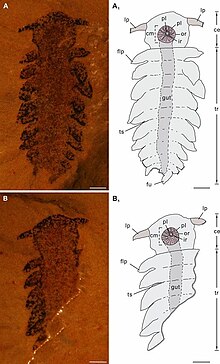小可愛蟲屬
始祖小可愛蟲(學名:Parvibellus atavus)是小可愛蟲屬(學名:Parvibellus)唯一一個物種,也是模式種。生存在寒武纪第三期。身上具有十一對的扇葉,頭部還有兩個小的突起物,和一個位在腹側、圓的口器。[1]是在中國雲南省海口鎮澄江化石地(Chengjiang Biota)和玉案山山峰( Yu’anshan (Heilinpu) Formation)發現的。[1]屬名是由parvus(微小)和bellus(可愛)組成的,因為身體的外觀而得名;而種小名-atavus(祖先),是因為這個物種具有很類似於泛節肢動物的體態。[1]目前只發現ELI-EJ048A這個標本。這些身體構造很像葉足動物、歐巴賓海蠍類還有放射齒目的物種,所以始祖小可愛蟲的分類可能位在恐蝦綱或是葉足動物之間。[1]
| 始祖小可愛蟲 | |
|---|---|

| |
| 始祖小可愛蟲的化石圖片。 | |
| 科学分类 | |
| 界: | 动物界 Animalia |
| 演化支: | 泛节肢动物 Panarthropoda |
| 演化支: | 序足动物 Tactopoda |
| 门: | 节肢动物门 Arthropoda |
| 纲: | †恐蝦綱 Dinocaridida |
| 属: | †小可愛蟲屬 Parvibellus Liu et al. 2022 |
| 种: | †始祖小可愛蟲 P. atavus
|
| 二名法 | |
| †Parvibellus atavus Liu et al. 2022
| |

形態 编辑
頭部 编辑
其中類似頭部的圓形部分約1.1毫米,最寬的部分為1.38毫米。[1]頭部區域的三分之一有一對突起物,那個凸起物有一點點稍微指向後方。[1]既巨大有圓形的口器位在頭部區域的腹側,嘴巴上的兩個圓圈都具有一排的牙齒,比較外側的齒環半徑約0.6毫米;比較內側的齒環半徑約0.18毫米。[1]大約有七片齒板在比較外側的齒環,有幾個在比較內側的齒環,但是發現齒板的化石都沒有保存很清楚。[1]
身體 编辑
全長大小約5.25毫米;而軀幹的部分長約4.07毫米,寬大約是1.1毫米。[1]身體側面的長的類似扇葉的突起物長約0.51毫米,最寬的地方約是0.26毫米,扇葉的突起物的基部(連接的部分)和末端有稍微變小。[1]身體有十一對類似扇葉的突起物,且平均的分布在軀幹上。[1]從身體到扇葉的突起物的連接部分不太明顯。[1]扇葉的突起物的輪廓大約是橢圓形或三角形。[1]扇葉的突起物可能像是歐巴賓海蠍類[2][3][4]或是放射齒目的物種[5]用來游泳[1],但是不太可能像是葉足動物的埃謝櫛蠶用來當作腳行走。[1][6]
分類 编辑
葉足動物 编辑
始祖小可愛蟲的樣子不像葉足動物,因為牠缺少了葉足動物應有的細長如蠕蟲的身軀。[1]外觀最像的葉足動物是埃謝櫛蠶[1],因為都有一對前附肢和十對當作腳的葉足[6][7];但是埃謝櫛蠶的身體有環紋,而且腳上還有爪子,且葉足動物大多是生活在海底的,而始祖小可愛蟲是可以自行游動的生物。[1]再加上比較早期的大多數葉足動物的口器(嘴巴)不是在腹側[7],但是愈年輕的物種的嘴巴都是在腹側,像是"具鰓葉足動物",例如:厭惡蟲屬(Pambdelurion )或是歐巴賓海蠍(Opabinia )或是比較與有爪動物相關的類群,例如:觸角棘足蟲屬(Antennacanthopodia)、三爪蟲屬(Tritonychus)。[1][8][9]
AOPK群 编辑
始祖小可愛蟲的扇葉突起物和位在腹側的口器與恐蝦綱(舊稱AOPK群[1][10][11][12][註 1])的物種很相似。但是在口器的方面,許多物種的嘴巴位置與始祖小可愛蟲不太一樣。在身體方面,始祖小可愛蟲有十一個扇葉突起物,而大多數恐蝦綱物種是八到十個扇葉。頭部還有一對看起來是前附肢,這個特徵在恐蝦綱幾乎每個物種都有。特別是放射齒目的物種與歐巴賓海蠍和厭惡蟲屬及宣揚爪蟲。[1]
發育 编辑
如果始祖小可愛蟲是年幼的放射齒目物種,那口器與眼睛和頭部的附肢可能尚未發育成熟,有一個例子反對這樣的想法。[1]Cong等人於2012年發表里拉琴蟲屬(Lyrarapax)[14],過了6年,Liu等人發現了里拉琴蟲的幼體化石,在那個幼體的里拉琴蟲化石上有完整的眼睛和口器,[15]所以始祖小可愛蟲不是放射齒目的物種。[1]
參考資料 编辑
- ^ 1.00 1.01 1.02 1.03 1.04 1.05 1.06 1.07 1.08 1.09 1.10 1.11 1.12 1.13 1.14 1.15 1.16 1.17 1.18 1.19 1.20 1.21 1.22 1.23 Liu, Jianni; Dunlop, Jason A.; Steiner, Michael; Shu, Degan. A Cambrian fossil from the Chengjiang fauna sharing characteristics with gilled lobopodians, opabiniids and radiodonts. Frontiers in Earth Science. 2022-07-22, 10. ISSN 2296-6463. doi:10.3389/feart.2022.861934.
- ^ Budd, Graham E. The morphology of Opabinia regalis and the reconstruction of the arthropod stem‐group. Lethaia. 1996-03, 29 (1). ISSN 0024-1164. doi:10.1111/j.1502-3931.1996.tb01831.x.
- ^ Budd, Graham E.; Daley, Allison C. The lobes and lobopods of Opabinia regalis from the middle Cambrian Burgess Shale. Lethaia. 2012-01, 45 (1). ISSN 0024-1164. doi:10.1111/j.1502-3931.2011.00264.x.
- ^ The enigmatic animal Opabinia regalis , middle Cambrian, Burgess Shale, British Columbia. Philosophical Transactions of the Royal Society of London. B, Biological Sciences. 1975-06-26, 271 (910). ISSN 0080-4622. doi:10.1098/rstb.1975.0033.
- ^ Van Roy, Peter; Daley, Allison C.; Briggs, Derek E. G. Anomalocaridid trunk limb homology revealed by a giant filter-feeder with paired flaps. Nature. 2015-03-11, 522 (7554). ISSN 0028-0836. doi:10.1038/nature14256.
- ^ 6.0 6.1 The Lobopod Animal Aysheaia pedunculata Walcott, Middle Cambrian, Burgess Shale, British Columbia. Philosophical Transactions of the Royal Society of London. B, Biological Sciences. 1978-11-16, 284 (1000). ISSN 0080-4622. doi:10.1098/rstb.1978.0061.
- ^ 7.0 7.1 Liu, Jianni; Dunlop, Jason A. Cambrian lobopodians: A review of recent progress in our understanding of their morphology and evolution. Palaeogeography, Palaeoclimatology, Palaeoecology. 2014-03, 398. ISSN 0031-0182. doi:10.1016/j.palaeo.2013.06.008.
- ^ Ou, Qiang; Liu, Jianni; Shu, Degan; Han, Jian; Zhang, Zhifei; Wan, Xiaoqiao; Lei, Qianping. A rare onychophoran-like lobopodian from the Lower Cambrian Chengjiang Lagerstätte, southwestern China, and its phylogenetic implications. Journal of Paleontology. 2011-05, 85 (3). ISSN 0022-3360. doi:10.1666/09-147r2.1.
- ^ Vinther, Jakob; Porras, Luis; Young, Fletcher J.; Budd, Graham E.; Edgecombe, Gregory D. The mouth apparatus of the Cambrian gilled lobopodian Pambdelurion whittingtoni. Palaeontology. 2016-09-26, 59 (6). ISSN 0031-0239. doi:10.1111/pala.12256.
- ^ Liu, Jianni; Shu, Degan; Han, Jian; Zhang, Zhifei; Zhang, Xingliang. Morpho‐anatomy of the lobopod Magadictyon cf. haikouensis from the Early Cambrian Chengjiang Lagerstätte, South China. Acta Zoologica. 2007-04-19, 88 (4). ISSN 0001-7272. doi:10.1111/j.1463-6395.2007.00281.x.
- ^ LIU, Jianni. A rare lobopod with well-preserved eyes from Chengjiang Lagersttte and its implications for origin of arthropods. Chinese Science Bulletin. 2004, 49 (10). ISSN 1001-6538. doi:10.1360/04wd0052.
- ^ Maas, Andreas; Mayer, Georg; Kristensen, Reinhardt M.; Waloszek, Dieter. A Cambrian micro-lobopodian and the evolution of arthropod locomotion and reproduction. Chinese Science Bulletin. 2007-12, 52 (24). ISSN 1001-6538. doi:10.1007/s11434-007-0515-3.
- ^ Budd, Graham E. The morphology and phylogenetic significance ofKerygmachela kierkegaardiBudd (Buen Formation, Lower Cambrian, N Greenland). Transactions of the Royal Society of Edinburgh: Earth Sciences. 1998, 89 (4). ISSN 0263-5933. doi:10.1017/s0263593300002418.
- ^ Cong, C; Ma, M; Hou, H; Edgecombe, E; Strausfeld, S. Brain structure resolves the segmental affinity of anomalocaridid appendages (PDF). MorphoBank datasets. 2015 [2024-01-27].
- ^ Liu, Jianni; Lerosey-Aubril, Rudy; Steiner, Michael; Dunlop, Jason A; Shu, Degan; Paterson, John R. Origin of raptorial feeding in juvenile euarthropods revealed by a Cambrian radiodontan. National Science Review. 2018-06-01, 5 (6). ISSN 2095-5138. doi:10.1093/nsr/nwy057.